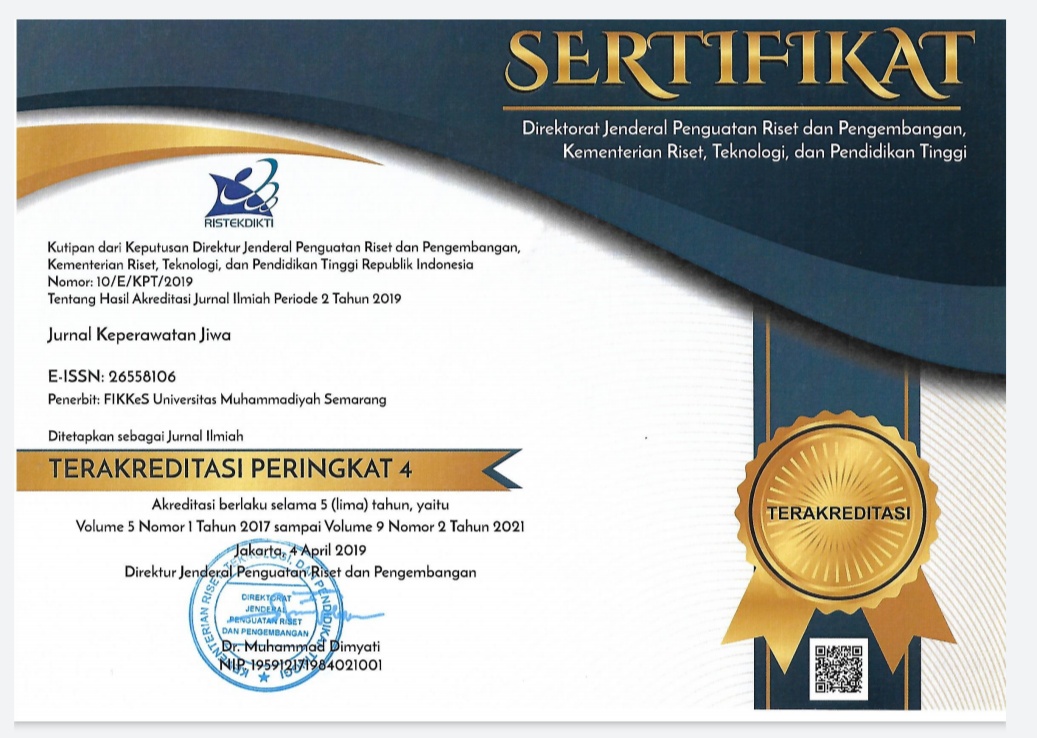Efektivitas Video Edukatif terhadap Keterampilan Mahasiswa pada Program Studi S1 Keperawatan dalam Melakukan Komunikasi Terapeutik
(1) Program Sarjana Keperawatan, Fakultas Ilmu Kesehatan, Universitas Nusa Nipa
(2) Program Sarjana Keperawatan, Fakultas Ilmu Kesehatan, Universitas Nusa Nipa
(*) Corresponding Author
Abstract
Keterampilan mahasiswa dalam melakukan komunikasi terapeutik kepada orang dengan gangguan jiwa menggunakan metode role play saat praktikum laboratorium dirasakan belum dapat membantu. Penelitian ini bertujuan untuk mengetahui pengaruh video edukasi terhadap keterampilan komunikasi. Terapeutik mahasiswa pada pasien gangguan jiwa. Penelitian ini menggunakan desain eksperimen semu dengan melakukan pretest dan posttest pada satu kelompok. Sampel penelitian sebanyak 30 mahasiswa semester VI dengan teknik total sampling. Pengumpulan data menggunakan lembar observasi kemampuan melakukan komunikasi terapeutik tentang strategi penerapan risiko perilaku kekerasan, yang disusun oleh Keliat, et al. (2015), Analisis data menggunakan uji Mc Nemar dengan α = 0,05. Hasi luji statistic diperoleh p value 0,000 <α (0,05). Dengan demikian kemampuan mahasiswa dalam melakukan komunikasi terapeutik meningkat setelah diberikan video edukasi sebesar 70%.
Keywords
Full Text:
PDFReferences
Abdolrahmi, M., Ghiyasvandian, S., & Zakerimoghadam, M. (2017). Therapeutic coomunication in nursing. Electronic Physician, 9(8), 4968–4977. https://www.ncbi.nlm.nih.gov/pmc/articles/PMC5614280/pdf/epj-09-4968.pdf
Arif, S., Cryder, B., Mazan, J., Quiñones-Boex, A., & Cyganska, A. (2017). Using patient case video vignettes to improve students’ understanding of cross-cultural communication. American Journal of Pharmaceutical Education, 81(3). https://doi.org/10.5688/ajpe81356
Cates, M. E., Mullins, K. M., & Woolley, T. W. (2019). Description of an elective course about mental illness and treatment in the movies. Pharmacy Education, 19(1), 108–115.
Choi, Y. J. (2012). Exploring experiences of psychiatric nursing simulations using standardized patients for undergraduate students. Asian Nursing Research, 6(3), 91–95. https://doi.org/10.1016/j.anr.2012.07.001
Donovan, L. M., & Mullen, L. K. (2019). Expanding nursing simulation programs with a standardized patient protocol on therapeutic communication. Nurse Education in Practice, 38(May), 126–131. https://doi.org/10.1016/j.nepr.2019.05.015
Elisabeth Coyne 1, Hazel Rands 2, Valda Frommolt 3, Victoria Kain 4, Melanie Plugge 5, M. M. 6. (n.d.). frommolt et al. https://doi.org/10.1016/j.nedt.2018.01.021
Felton, A., & Wright, N. (2017). Simulation in mental health nurse education: The development, implementation and evaluation of an educational innovation. Nurse Education in Practice, 26, 46–52. https://doi.org/10.1016/j.nepr.2017.06.005
Fossen, P., & Stoeckel, P. R. (2016). Nursing students’ perceptions of a hearing voices simulation and role-play: Preparation for mental health clinical practice. Journal of Nursing Education, 55(4), 203–208. https://doi.org/10.3928/01484834-20160316-04
Furnes, M., Kvaal, K. S., & Høye, S. (2018). Communication in mental health nursing - Bachelor Students’ appraisal of a blended learning training programme - An exploratory study. BMC Nursing, 17(1), 1–10. https://doi.org/10.1186/s12912-018-0288-9
Ghiyasvandian, S., Abdolrahimi, M., Zakerimoghadam, M., & Ebadi, A. (2018). Therapeutic communication of Iranian nursing students: A qualitative study. Pertanika Journal of Social Sciences and Humanities, 26(3), 1757–1774.
Gutiérrez-Puertas, L., Márquez-Hernández, V. V., Gutiérrez-Puertas, V., Granados-Gámez, G., & Aguilera-Manrique, G. (2020). Educational interventions for nursing students to develop communication skills with patients: A systematic review. International Journal of Environmental Research and Public Health, 17(7). https://doi.org/10.3390/ijerph17072241
Haraldseid, C., Friberg, F., & Aase, K. (2015). Nursing students’ perceptions of factors influencing their learning environment in a clinical skills laboratory: A qualitative study. Nurse Education Today, 35(9), e1–e6. https://doi.org/10.1016/j.nedt.2015.03.015
Kononowicz, A. A., Woodham, L. A., Edelbring, S., Stathakarou, N., Davies, D., Saxena, N., Car, L. T., Carlstedt-Duke, J., Car, J., & Zary, N. (2019). Virtual patient simulations in health professions education: Systematic review and meta-analysis by the digital health education collaboration. Journal of Medical Internet Research, 21(7), 1–20. https://doi.org/10.2196/14676
Lai, C. Y., Chen, L. J., Yen, Y. C., & Lin, K. Y. (2020). Impact of video annotation on undergraduate nursing students’ communication performance and commenting behaviour during an online peer-assessment activity. Australasian Journal of Educational Technology, 36(2), 71–88. https://doi.org/10.14742/AJET.4341
Lee, N., Chae, S., Kim, H., Lee, J., Min, H. J., & Park, D. (2016). Mobile-Based Video Learning Outcomes in Clinical. January, 8–16.
Ndiwane, A. N., Baker, N. C., Makosky, A., Reidy, P., & Guarino, A. J. (2017). Use of simulation to integrate cultural humility into advanced health assessment for nurse practitioner students. Journal of Nursing Education, 56(9), 567–571. https://doi.org/10.3928/01484834-20170817-11
Park, H., Park, J., Kim, C., & Song, J. (2016). integrated nursing practicum. 7–9.
Ristekdikti. (2018). Vol.8.I.2018 1. Media Pustakawan, 8, 1–56.
Sehat, D., & Gangguan, R. D. A. N. (2015). Standar asuhan keperawatan jiwa diagnosa sehat, resiko dan gangguan.
Tufford, L., Asakura, K., & Bogo, M. (2018). Simulation Versus Role-Play: Perceptions of Prepracticum BSW Students. Journal of Baccalaureate Social Work, 23(1), 249–267. https://doi.org/10.18084/1084-7219.23.1.249
Williams, B., Reddy, P., Marshall, S., Beovich, B., & McKarney, L. (2017). Simulation and mental health outcomes: a scoping review. Advances in Simulation, 2(1), 1–8. https://doi.org/10.1186/s41077-016-0035-9
Article Metrics
Abstract view : 522 timesPDF - 123 times
DOI: https://doi.org/10.26714/jkj.9.3.2021.711-718
Refbacks
- There are currently no refbacks.

This work is licensed under a Creative Commons Attribution 4.0 International License.
PPNI Univ. Muhammadiyah Semarang
Jl. Kedungmundu Raya No. 18 Semarang Gedung NRC University of Muhammadiyah Semarang
Phone: 02476740287
Fax: 02476740287
Email: [email protected]
This work is licensed under a Creative Commons Attribution 4.0 International License.


